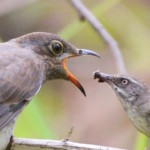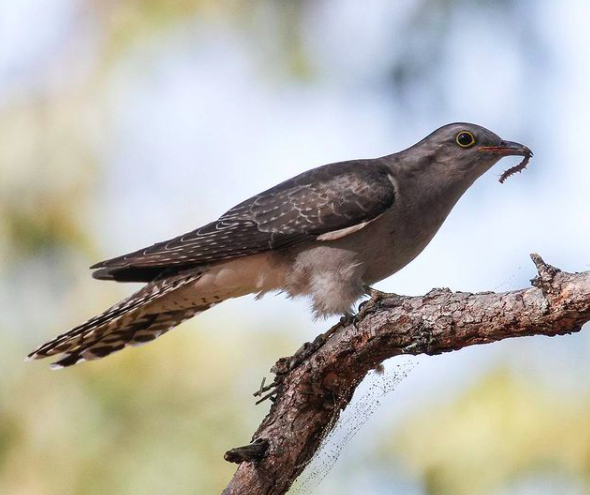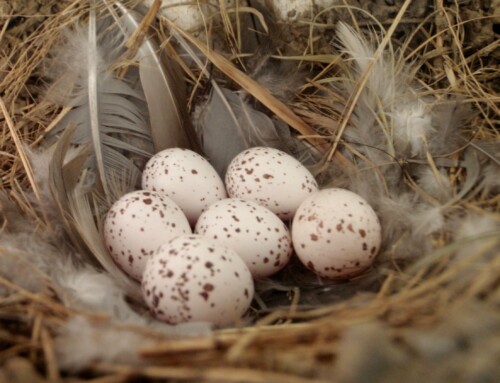Report from a BOU-funded project
LINKED PAPERS
Notes on the parasitic ecology of newly-fledged Fan-Tailed Cuckoos Cacomantis flabelliformis and their White-Browed Scrubwren Sericornis frontalis hosts in south-east Queensland. Poje C., Kennerley J.A., Richardson N.M., Grundler M.R., Cowan Z.-L., Marsh M., Feeney W.E. 2019 The Sunbird. VIEW
First record of brood adoption in the superb fairy-wren Malurus cyaneus. Richardson, N.M., Kennerley, J.A., Feeney, W.E. 2019 The Sunbird. VIEW
Observations on the behaviour and ecology of the Pallid Cuckoo Heteroscenes pallidus in south-east Queensland. Kennerley, J.A., Grundler, M.R., Richardson, N.M., Marsh, M., Grayum, J., Feeney, W.E. 2019 Australian Field Ornithology. VIEW
 Despite the wonderful diversity of research into the world’s avifauna, we are still lacking a surprising amount of basic information on the natural habits of the majority. I started working on understanding the ecology and evolution of the relationships between Australia’s cuckoos and their hosts during my PhD, and was very fortunate to have had access to several well-established field sites in Canberra and Lara (near Melbourne) to conduct my research.
Despite the wonderful diversity of research into the world’s avifauna, we are still lacking a surprising amount of basic information on the natural habits of the majority. I started working on understanding the ecology and evolution of the relationships between Australia’s cuckoos and their hosts during my PhD, and was very fortunate to have had access to several well-established field sites in Canberra and Lara (near Melbourne) to conduct my research.
After finishing my PhD, I sought to continue working on these fascinating relationships, and teamed up with researchers from Cornell University to extend on their existing efforts to build our own long-term ornithological research program near Brisbane, Australia (@samsonvalebirdproject on instagram). I am originally from Brisbane, and figured that this location was perfect due to the diversity of species found in the region. For instance, 257 species have been recorded at our site according to eBird, and it also regularly hosts 10 of Australia’s 12 parasitic cuckoos (as well as Australia’s only non-parasitic cuckoo, the Pheasant Coucal).
Nobody had previously studied cuckoo-host relationships around Brisbane, which meant that first we needed to understand what cuckoo species are common in this area, and what species they parasitized. Further, one of the key aims of our work is to understand how the evolutionary “arms races” that exist between cuckoos and hosts operate in an area where numerous cuckoos and hosts coexist and interact with one another. This is interesting because the majority of work on cuckoos and other brood parasites (e.g. the cowbirds of the Americas) has been conducted in Europe and North America, and these areas only host a few brood parasite species. Further, as brood parasitic cuckoos tend to rely on deceiving their hosts, such as by laying eggs that mimic those of their hosts, they need to be rare to be successful as parasites. While exciting and unique, these factors have meant that we must monitor hundreds of nests from multiple host species each year, which is a substantial task. This work is ongoing, but our first studies on this topic are currently being prepared.
The scale of our project means that we host numerous undergraduate researchers, who help with monitoring efforts in addition to leading their own research projects. We have been fortunate to host some very capable and passionate young ornithologists some of whom have a knack for making previously unseen natural history observations. For instance, while we can usually predict around about when we can expect the first cuckoo eggs to show up, sometimes the birds have a different schedule. In 2017, by the time we started our field season (usually around July, as this is when fairy-wrens [Maluridae] and scrubwrens [Acanthizidae] tend to start nesting) several Fan-tailed Cuckoos (Cacomantis flabelliformis) had already fledged from their host White-browed Scrubwren (Sericornis frontalis). Acting quickly, Colleen Poje (now a PhD student at Cornell University) saw this as an opportunity to lead a study investigating how scrubwrens fledglings interact with other species (Poje et al. 2019).
We found that newly fledged cuckoos are relentless when it comes to begging. For instance, while the cuckoos attempted to solicit food from numerous bird species (some of which seemed inquisitive, while others were aggressive) and even a butterfly, only the foster parent scrubwrens fed them, with the female bearing the brunt of the work. Additionally, we also noticed that when predators (e.g. Eastern Brown Snakes [Pseudonaja textilis] or Lace Monitors [Varanus varius]) were nearby, all of the other birds either became quiet or alarmed towards the predator, while the cuckoo fledglings just kept begging. These types of observational data are difficult to collect, and as such, this study is the first to record these kinds of behaviour in this species.
 Figure 1 A juvenile Fan-tailed Cuckoo being fed by an adult White-browed Scrubwren at Lake Samsonvale, Queensland, Australia. Photo by Cameryn Brock.
Figure 1 A juvenile Fan-tailed Cuckoo being fed by an adult White-browed Scrubwren at Lake Samsonvale, Queensland, Australia. Photo by Cameryn Brock.
Likewise, during the same year Nicole Richardson noticed some unusual parental behaviours in Superb Fairy-wrens (Richardson et al. 2019). Superb Fairy-wrens are facultative cooperative breeders, which means that groups of birds contribute to the care of offspring – usually the dominant male and female as well as one or several males from a previous brood. These are extremely well studied birds, with very well studied social systems; however, Nicole noticed something that had never previously been seen in this species. The Superb Fairy-wrens that we monitor are colour banded, allowing us to follow the lives of each individual over years. What Nicole saw is the sort of stuff you might expect in a soap opera. Basically: two nearby nests with nestlings of a similar age and the male goes missing from one while the female and the nestlings go missing from the other (predation is common and the likely cause). Then the lone female appeared to partner with the male and his chicks, until they were independent, after which she returned to her usual territory and found a new male. This instance of nestling adoption was strange, and a behaviour that is surprisingly rare in passerines, making the Superb Fairy-wrens one of only three passerine species in which it is reported.
2017 was also an unusually hot and dry year (though, the type of unusual that is becoming worryingly common), and we observed numerous uncommon species at our site. James Kennerley (now a PhD student at the University of Cambridge) took the opportunity offered by these unusual circumstances to make the first notes on the natural habits of the Pallid Cuckoo (Cacomantis pallidus). Pallid Cuckoos are typically not found around Brisbane (they prefer drier areas); however, in 2017 we had at least six individuals at our site for about 16 weeks. Several new observations were made: males appear to hold much larger home ranges than females, male-female pairing behaviours that are consistent with the idea of this species potentially being socially monogamous, the first record of parasitism in the region (a juvenile Pallid Cuckoo being fed by a Lewin’s Honeyeater [Meliphaga lewinii]), and we also observed what appears to be a newly described intermediate plumage morph in an adult female.
 Figure 2 A Pallid Cuckoo from Lake Samsonvale, Queensland, Australia. Photo by James Kennerley.
Figure 2 A Pallid Cuckoo from Lake Samsonvale, Queensland, Australia. Photo by James Kennerley.
I love this kind of research, because in addition to providing new insights into the ecology of species, these kinds of natural history observations set the stage for more substantive eco-evolutionary research down the track. Further, both starting up a new field-program and hypothesis-driven research take time. These kinds of observations are inevitable when intensive work occurs at a new location; however, it often goes unpublished. I am really fortunate that I have had the opportunity to host such passionate young researchers at my program, who have embraced these opportunities and published some nice new observations into the behaviour and ecology of Australia’s birdlife.
Funding
William Feeney (Research Fellow, University of Queensland, Australia) was awarded a small ornithological grant of £1,400 in 2017 for a project entitled ‘Cross parasitism is the norm, rather than the exception, in an area where multiple cuckoos and multiple hosts co-occur’.
References
Feeney, W.E., Medina, I., Somveille, M., Heinsohn, R., Hall, M.L., Mulder, R.A., Stein, J.A., Kilner, R.M. & Langmore, N.E. 2013. Brood parasitism and the evolution of cooperative breeding in birds. Science 342: 1506-1508.VIEW
Image credit
Top right: Juvenile Fan-tailed Cuckoo Cacomantis flabelliformis and adult White-browed Scrubwren Sericornis frontalis © Cameryn Brock




